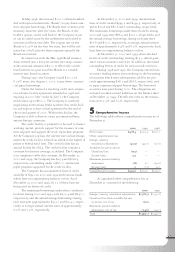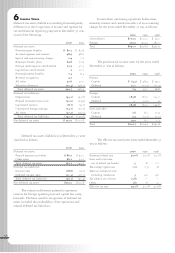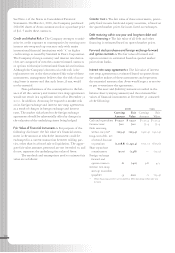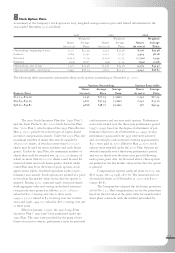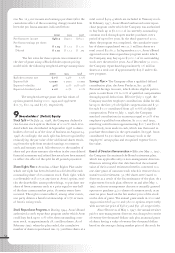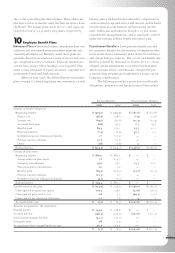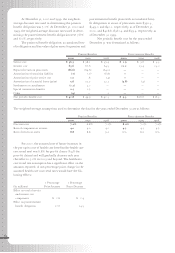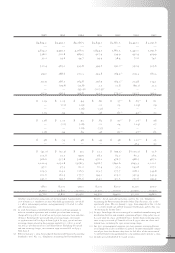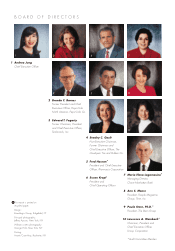Avon 2000 Annual Report Download - page 37
Download and view the complete annual report
Please find page 37 of the 2000 Avon annual report below. You can navigate through the pages in the report by either clicking on the pages listed below, or by using the keyword search tool below to find specific information within the annual report.
67
Foreign Exchange > Financial statement translation of
subsidiaries operating in highly inflationary economies
and foreign currency transactions resulted in losses (gains)
in 2000 netting to $12.6 (1999–$7.5; 1998–$(1.1)),
which are included in other expense (income), net and
income taxes. In addition, cost of sales and expenses
include the unfavorable impact of the translation of
inventories and prepaid expenses at historical rates in
countries with highly inflationary economies in 2000 of
$3.2 (1999 –$7.1; 1998 –$15.8).
12 Leases and Commitments
Minimum rental commitments under noncancellable
operating leases, primarily for equipment and office facili-
ties at December 31, 2000, consisted of the following:
Year
2001 $ 69.1
2002 52.8
2003 40.6
2004 33.1
2005 29.1
Later years 225.3
Sublease rental income (4.5)
Total $445.5
Rent expense in 2000 was $85.4 (1999 –$84.5;
1998 –$84.7). Various construction and information sys-
tems projects were in progress at December 31, 2000, with
an estimated cost to complete of approximately $130.0.
13 Special and Non-Recurring Charges
In October 1997, the Company announced a worldwide
business process redesign program to streamline opera-
tions and improve profitability through margin improve-
ment and expense reductions. The special and non-
recurring charges associated with this program totaled
$151.2 pretax ($121.9 net of tax, or $.47 per share on a
basic and diluted basis) for the year ended December 31,
1999 and totaled $154.4 pretax ($122.8 net of tax, or
$.46 per share on a basic and diluted basis) for the year
ended December 31, 1998.
Special and non-recurring charges by business seg-
ment are as follows:
1999 1998
North America $ 33.6 $ 84.6
Latin America 14.7 6.3
Europe 69.8 18.2
Pacific 11.8 27.3
Corporate 21.3 18.0
Total $151.2 $ 154.4
Special and non-recurring charges by category
of expenditures are as follows for the years ended
December 31:
1999
Cost of
Special Sales
Charges Charge Total
Employee severance costs $ 57.0 $ — $ 57.0
Inventories — 46.0 46.0
Writedown of assets to net
realizable value 26.4 — 26.4
Recognition of foreign
currency translation adjustment 9.8 — 9.8
Other 12.0 — 12.0
$105.2 $ 46.0 $151.2
1998
Cost of
Special Sales
Charges Charge Total
Employee severance costs $ 56.4 $ — $ 56.4
Inventories — 37.9 37.9
Writedown of assets to net
realizable value 31.8 — 31.8
Field program buy-out 14.4 — 14.4
Other 13.9 — 13.9
$116.5 $ 37.9 $154.4
Employee severance costs are expenses, both domes-
tic and international, associated with the realignment
of the Company’s global operations. Certain employee
severance costs were accounted for in accordance with the
Company’s existing fas 112 (“Employers’ Accounting
for Postemployment Benefits”) severance plans. Remaining
severance costs were accounted for in accordance with
other accounting literature. The workforce was reduced
by approximately 3,700 employees, or 9% of the total.
Approximately one-half of the terminated employees
related to the facility closures. As of December 31, 2000,
all employees under the program have been terminated.
Inventory-related charges represent losses to write
down the carrying value of non-strategic inventory prior
to disposal. The 1999 charges primarily result from a
new business strategy for product dispositions which
fundamentally changes the way the Company markets
and sells certain inventory. This new strategy, approved
and effective in March 1999, is meant to complement
other redesign initiatives, with the objective of reducing
inventory clearance sales, building core brochure sales
and building global brands. The 1998 charges resulted
from the closure of facilities, discontinuation of certain
product lines, size-of-line reductions and a change in
strategy for product dispositions.


